
Products: Abaqus/Standard Abaqus/Explicit Abaqus/CAE

This section provides a reference to the three-dimensional solid elements available in Abaqus/Standard and Abaqus/Explicit.

| C3D4 | 4-node linear tetrahedron |
| C3D4H(S) | 4-node linear tetrahedron, hybrid with linear pressure |
| C3D5(S) | 5-node linear pyramid |
| C3D5H(S) | 5-node linear pyramid, hybrid with constant pressure |
| C3D6(S) | 6-node linear triangular prism |
| C3D6(E) | 6-node linear triangular prism, reduced integration with hourglass control |
| C3D6H(S) | 6-node linear triangular prism, hybrid with constant pressure |
| C3D8 | 8-node linear brick |
| C3D8H(S) | 8-node linear brick, hybrid with constant pressure |
| C3D8I | 8-node linear brick, incompatible modes |
| C3D8IH(S) | 8-node linear brick, incompatible modes, hybrid with linear pressure |
| C3D8R | 8-node linear brick, reduced integration with hourglass control |
| C3D8RH(S) | 8-node linear brick, reduced integration with hourglass control, hybrid with constant pressure |
| C3D8S(S) | 8-node linear brick, improved surface stress visualization |
| C3D8HS(S) | 8-node linear brick, hybrid with constant pressure, improved surface stress visualization |
| C3D10(S) | 10-node quadratic tetrahedron |
| C3D10H(S) | 10-node quadratic tetrahedron, hybrid with constant pressure |
| C3D10HS(S) | 10-node general-purpose quadratic tetrahedron, improved surface stress visualization |
| C3D10M | 10-node modified tetrahedron, with hourglass control |
| C3D10MH(S) | 10-node modified tetrahedron, with hourglass control, hybrid with linear pressure |
| C3D15(S) | 15-node quadratic triangular prism |
| C3D15H(S) | 15-node quadratic triangular prism, hybrid with linear pressure |
| C3D20(S) | 20-node quadratic brick |
| C3D20H(S) | 20-node quadratic brick, hybrid with linear pressure |
| C3D20R(S) | 20-node quadratic brick, reduced integration |
| C3D20RH(S) | 20-node quadratic brick, reduced integration, hybrid with linear pressure |
The constant pressure hybrid elements have one additional variable relating to pressure, and the linear pressure hybrid elements have four additional variables relating to pressure.
Element types C3D8I and C3D8IH have thirteen additional variables relating to the incompatible modes.
Element types C3D10M and C3D10MH have three additional displacement variables.
| C3D15V(S) | 15 to 18-node triangular prism |
| C3D15VH(S) | 15 to 18-node triangular prism, hybrid with linear pressure |
| C3D27(S) | 21 to 27-node brick |
| C3D27H(S) | 21 to 27-node brick, hybrid with linear pressure |
| C3D27R(S) | 21 to 27-node brick, reduced integration |
| C3D27RH(S) | 21 to 27-node brick, reduced integration, hybrid with linear pressure |
| C3D4T | 4-node linear displacement and temperature |
| C3D6T(S) | 6-node linear displacement and temperature |
| C3D6T(E) | 6-node linear displacement and temperature, reduced integration with hourglass control |
| C3D6HT(S) | 6-node linear displacement and temperature, hybrid with constant pressure |
| C3D8T | 8-node trilinear displacement and temperature |
| C3D8HT(S) | 8-node trilinear displacement and temperature, hybrid with constant pressure |
| C3D8RT | 8-node trilinear displacement and temperature, reduced integration with hourglass control |
| C3D8RHT(S) | 8-node trilinear displacement and temperature, reduced integration with hourglass control, hybrid with constant pressure |
| C3D10T(S) | 10-node triquadratic displacement, trilinear temperature |
| C3D10HT(S) | 10-node triquadratic displacement, trilinear temperature, hybrid with constant pressure |
| C3D10MT | 10-node modified displacement and temperature tetrahedron, with hourglass control |
| C3D10MHT(S) | 10-node modified displacement and temperature tetrahedron, with hourglass control, hybrid with linear pressure |
| C3D20T(S) | 20-node triquadratic displacement, trilinear temperature |
| C3D20HT(S) | 20-node triquadratic displacement, trilinear temperature, hybrid with linear pressure |
| C3D20RT(S) | 20-node triquadratic displacement, trilinear temperature, reduced integration |
| C3D20RHT(S) | 20-node triquadratic displacement, trilinear temperature, reduced integration, hybrid with linear pressure |
1, 2, 3, 11 at corner nodes
1, 2, 3 at midside nodes of second-order elements in Abaqus/Standard
1, 2, 3, 11 at midside nodes of modified displacement and temperature elements in Abaqus/Standard
The constant pressure hybrid element has one additional variable relating to pressure, and the linear pressure hybrid elements have four additional variables relating to pressure.
Element types C3D10MT and C3D10MHT have three additional displacement variables and one additional temperature variable.
| Q3D4(S) | 4-node linear displacement, electric potential and temperature |
| Q3D6(S) | 6-node linear displacement, electric potential and temperature |
| Q3D8(S) | 8-node trilinear displacement, electric potential and temperature |
| Q3D8H(S) | 8-node trilinear displacement, electric potential and temperature, hybrid with constant pressure |
| Q3D8R(S) | 8-node trilinear displacement, electric potential and temperature, reduced integration with hourglass control |
| Q3D8RH(S) | 8-node trilinear displacement, electric potential and temperature, reduced integration with hourglass control, hybrid with constant pressure |
| Q3D10M(S) | 10-node modified displacement, electric potential and temperature tetrahedron, with hourglass control |
| Q3D10MH(S) | 10-node modified displacement, electric potential and temperature tetrahedron, with hourglass control, hybrid with linear pressure |
| Q3D20(S) | 20-node triquadratic displacement, trilinear electric potential and trilinear temperature |
| Q3D20H(S) | 20-node triquadratic displacement, trilinear electric potential, trilinear temperature, hybrid with linear pressure |
| Q3D20R(S) | 20-node triquadratic displacement, trilinear electric potential, trilinear temperature, reduced integration |
| Q3D20RH(S) | 20-node triquadratic displacement, trilinear electric potential, trilinear temperature, reduced integration, hybrid with linear pressure |
1, 2, 3, 9, 11 at corner nodes
1, 2, 3 at midside nodes of second-order elements in Abaqus/Standard
1, 2, 3, 9, 11 at midside nodes of modified displacement and temperature elements in Abaqus/Standard
The constant pressure hybrid element has one additional variable relating to pressure, and the linear pressure hybrid elements have four additional variables relating to pressure.
Element types Q3D10M and Q3D10MH have three additional displacement variables, one additional electric potential variable, and one additional temperature variable.
| DC3D4(S) | 4-node linear tetrahedron |
| DC3D6(S) | 6-node linear triangular prism |
| DC3D8(S) | 8-node linear brick |
| DC3D10(S) | 10-node quadratic tetrahedron |
| DC3D15(S) | 15-node quadratic triangular prism |
| DC3D20(S) | 20-node quadratic brick |
| DC3D4E(S) | 4-node linear tetrahedron |
| DC3D6E(S) | 6-node linear triangular prism |
| DC3D8E(S) | 8-node linear brick |
| DC3D10E(S) | 10-node quadratic tetrahedron |
| DC3D15E(S) | 15-node quadratic triangular prism |
| DC3D20E(S) | 20-node quadratic brick |
| C3D4P(S) | 4-node linear displacement and pore pressure |
| C3D4PH(S) | 4-node linear displacement and pore pressure, hybrid with linear pressure |
| C3D6P(S) | 6-node linear displacement and pore pressure |
| C3D6PH(S) | 6-node linear displacement and pore pressure, hybrid with constant pressure |
| C3D8P(S) | 8-node trilinear displacement and pore pressure |
| C3D8PH(S) | 8-node trilinear displacement and pore pressure, hybrid with constant pressure |
| C3D8RP(S) | 8-node trilinear displacement and pore pressure, reduced integration |
| C3D8RPH(S) | 8-node trilinear displacement and pore pressure, reduced integration, hybrid with constant pressure |
| C3D10P(S) | 10-node triquadratic displacement, trilinear pore pressure |
| C3D10PH(S) | 10-node triquadratic displacement, trilinear pore pressure, hybrid with constant pressure |
| C3D10MP(S) | 10-node modified displacement and pore pressure tetrahedron, with hourglass control |
| C3D10MPH(S) | 10-node modified displacement and pore pressure tetrahedron, with hourglass control, hybrid with linear pressure |
| C3D20P(S) | 20-node triquadratic displacement, trilinear pore pressure |
| C3D20PH(S) | 20-node triquadratic displacement, trilinear pore pressure, hybrid with linear pressure |
| C3D20RP(S) | 20-node triquadratic displacement, trilinear pore pressure, reduced integration |
| C3D20RPH(S) | 20-node triquadratic displacement, trilinear pore pressure, reduced integration, hybrid with linear pressure |
1, 2, 3 at midside nodes for all elements except C3D10MP and C3D10MPH, which also have degree of freedom 8 active at midside nodes
1, 2, 3, 8 at corner nodes
The constant pressure hybrid elements have one additional variable relating to the effective pressure stress, and the linear pressure hybrid elements have four additional variables relating to the effective pressure stress to permit fully incompressible material modeling.
Element types C3D10MP and C3D10MPH have three additional displacement variables and one additional pore pressure variable.
| C3D4PT(S) | 4-node trilinear displacement, pore pressure, and temperature |
| C3D4PHT(S) | 4-node trilinear displacement, pore pressure, and temperature; hybrid with linear pressure |
| C3D6PT(S) | 6-node trilinear displacement, pore pressure, and temperature |
| C3D6PHT(S) | 6-node trilinear displacement, pore pressure, and temperature; hybrid with constant pressure |
| C3D8PT(S) | 8-node trilinear displacement, pore pressure, and temperature |
| C3D8PHT(S) | 8-node trilinear displacement, pore pressure, and temperature; hybrid with constant pressure |
| C3D8RPT(S) | 8-node trilinear displacement, pore pressure, and temperature; reduced integration |
| C3D8RPHT(S) | 8-node trilinear displacement, pore pressure, and temperature; reduced integration, hybrid with constant pressure |
| C3D10MPT(S) | 10-node modified displacement, pore pressure, and temperature tetrahedron, with hourglass control |
| C3D10PT(S) | 10-node triquadratic displacement, trilinear pore pressure, and temperature |
| C3D10PHT(S) | 10-node triquadratic displacement, trilinear pore pressure, and temperature; hybrid with constant pressure |
The constant pressure hybrid elements have one additional variable relating to the effective pressure stress to permit fully incompressible material modeling.
Element type C3D10MPT has three additional displacement variables, one additional pore pressure variable, and one additional temperature variable.
| AC3D4 | 4-node linear tetrahedron |
| AC3D5 | 5-node linear pyramid |
| AC3D6 | 6-node linear triangular prism |
| AC3D8(S) | 8-node linear brick |
| AC3D8R(E) | 8-node linear brick, reduced integration with hourglass control |
| AC3D10(S) | 10-node quadratic tetrahedron |
| AC3D15(S) | 15-node quadratic triangular prism |
| AC3D20(S) | 20-node quadratic brick |
| C3D4E(S) | 4-node linear tetrahedron |
| C3D6E(S) | 6-node linear triangular prism |
| C3D8E(S) | 8-node linear brick |
| C3D10E(S) | 10-node quadratic tetrahedron |
| C3D15E(S) | 15-node quadratic triangular prism |
| C3D20E(S) | 20-node quadratic brick |
| C3D20RE(S) | 20-node quadratic brick, reduced integration |
| EMC3D4(S) | 4-node zero-order |
| EMC3D6(S) | 6-node zero-order |
| EMC3D8(S) | 8-node zero-order |
Magnetic vector potential (for more information, see “Boundary conditions” in “Eddy current analysis,” Section 6.7.5, and “Boundary conditions” in “Magnetostatic analysis,” Section 6.7.6).

| Input File Usage: | *SOLID SECTION |
| Abaqus/CAE Usage: | Property module: Create Section: select Solid as the section Category and Homogeneous or Electromagnetic, Solid as the section Type |

Distributed loads are available for all elements with displacement degrees of freedom. They are specified as described in “Distributed loads,” Section 34.4.3.
Load ID (*DLOAD): BX
Abaqus/CAE Load/Interaction: Body force
Units: FL–3
Description: Body force in global X-direction.
Load ID (*DLOAD): BY
Abaqus/CAE Load/Interaction: Body force
Units: FL–3
Description: Body force in global Y-direction.
Load ID (*DLOAD): BZ
Abaqus/CAE Load/Interaction: Body force
Units: FL–3
Description: Body force in global Z-direction.
Load ID (*DLOAD): BXNU
Abaqus/CAE Load/Interaction: Body force
Units: FL–3
Description: Nonuniform body force in global X-direction with magnitude supplied via user subroutine DLOAD in Abaqus/Standard and VDLOAD in Abaqus/Explicit.
Load ID (*DLOAD): BYNU
Abaqus/CAE Load/Interaction: Body force
Units: FL–3
Description: Nonuniform body force in global Y-direction with magnitude supplied via user subroutine DLOAD in Abaqus/Standard and VDLOAD in Abaqus/Explicit.
Load ID (*DLOAD): BZNU
Abaqus/CAE Load/Interaction: Body force
Units: FL–3
Description: Nonuniform body force in global Z-direction with magnitude supplied via user subroutine DLOAD in Abaqus/Standard and VDLOAD in Abaqus/Explicit.
Load ID (*DLOAD): CENT(S)
Abaqus/CAE Load/Interaction: Not supported
Units: FL–4(ML–3T–2)
Description: Centrifugal load (magnitude is input as ![]() , where
, where ![]() is the mass density per unit volume,
is the mass density per unit volume, ![]() is the angular velocity). Not available for pore pressure elements.
is the angular velocity). Not available for pore pressure elements.
Load ID (*DLOAD): CENTRIF(S)
Abaqus/CAE Load/Interaction: Rotational body force
Units: T–2
Description: Centrifugal load (magnitude is input as ![]() , where
, where ![]() is the angular velocity).
is the angular velocity).
Load ID (*DLOAD): CORIO(S)
Abaqus/CAE Load/Interaction: Coriolis force
Units: FL–4T (ML–3T–1)
Description: Coriolis force (magnitude is input as ![]() , where
, where ![]() is the mass density per unit volume,
is the mass density per unit volume, ![]() is the angular velocity). Not available for pore pressure elements.
is the angular velocity). Not available for pore pressure elements.
Load ID (*DLOAD): GRAV
Abaqus/CAE Load/Interaction: Gravity
Units: LT–2
Description: Gravity loading in a specified direction (magnitude is input as acceleration).
Load ID (*DLOAD): HPn(S)
Abaqus/CAE Load/Interaction: Not supported
Units: FL–2
Description: Hydrostatic pressure on face n, linear in global Z.
Load ID (*DLOAD): Pn
Abaqus/CAE Load/Interaction: Pressure
Units: FL–2
Description: Pressure on face n.
Load ID (*DLOAD): PnNU
Abaqus/CAE Load/Interaction: Not supported
Units: FL–2
Description: Nonuniform pressure on face n with magnitude supplied via user subroutine DLOAD in Abaqus/Standard and VDLOAD in Abaqus/Explicit.
Load ID (*DLOAD): ROTA(S)
Abaqus/CAE Load/Interaction: Rotational body force
Units: T–2
Description: Rotary acceleration load (magnitude is input as ![]() , where
, where ![]() is the rotary acceleration).
is the rotary acceleration).
Load ID (*DLOAD): ROTDYNF(S)
Abaqus/CAE Load/Interaction: Not supported
Units: T–1
Description: Rotordynamic load (magnitude is input as ![]() , where
, where ![]() is the angular velocity).
is the angular velocity).
Load ID (*DLOAD): SBF(E)
Abaqus/CAE Load/Interaction: Not supported
Units: FL–5T2
Description: Stagnation body force in global X-, Y-, and Z-directions.
Load ID (*DLOAD): SPn(E)
Abaqus/CAE Load/Interaction: Not supported
Units: FL–4T2
Description: Stagnation pressure on face n.
Load ID (*DLOAD): TRSHRn
Abaqus/CAE Load/Interaction: Surface traction
Units: FL–2
Description: Shear traction on face n.
Load ID (*DLOAD): TRSHRnNU(S)
Abaqus/CAE Load/Interaction: Not supported
Units: FL–2
Description: Nonuniform shear traction on face n with magnitude and direction supplied via user subroutine UTRACLOAD.
Load ID (*DLOAD): TRVECn
Abaqus/CAE Load/Interaction: Surface traction
Units: FL–2
Description: General traction on face n.
Load ID (*DLOAD): TRVECnNU(S)
Abaqus/CAE Load/Interaction: Not supported
Units: FL–2
Description: Nonuniform general traction on face n with magnitude and direction supplied via user subroutine UTRACLOAD.
Load ID (*DLOAD): VBF(E)
Abaqus/CAE Load/Interaction: Not supported
Units: FL–4T
Description: Viscous body force in global X-, Y-, and Z-directions.
Load ID (*DLOAD): VPn(E)
Abaqus/CAE Load/Interaction: Not supported
Units: FL–3T
Description: Viscous pressure on face n, applying a pressure proportional to the velocity normal to the face and opposing the motion.
Foundations are available for Abaqus/Standard elements with displacement degrees of freedom. They are specified as described in “Element foundations,” Section 2.2.2.
Load ID (*FOUNDATION): Fn(S)
Abaqus/CAE Load/Interaction: Elastic foundation
Units: FL–3
Description: Elastic foundation on face n.
Distributed heat fluxes are available for all elements with temperature degrees of freedom. They are specified as described in “Thermal loads,” Section 34.4.4.
Load ID (*DFLUX): BF
Abaqus/CAE Load/Interaction: Body heat flux
Units: JL–3T–1
Description: Heat body flux per unit volume.
Load ID (*DFLUX): BFNU
Abaqus/CAE Load/Interaction: Body heat flux
Units: JL–3T–1
Description: Nonuniform heat body flux per unit volume with magnitude supplied via user subroutine DFLUX in Abaqus/Standard and VDFLUX in Abaqus/Explicit.
Load ID (*DFLUX): Sn
Abaqus/CAE Load/Interaction: Surface heat flux
Units: JL–2T–1
Description: Heat surface flux per unit area into face n.
Load ID (*DFLUX): SnNU
Abaqus/CAE Load/Interaction: Not supported
Units: JL–2T–1
Description: Nonuniform heat surface flux per unit area into face n with magnitude supplied via user subroutine DFLUX in Abaqus/Standard and VDFLUX in Abaqus/Explicit.
Film conditions are available for all elements with temperature degrees of freedom. They are specified as described in “Thermal loads,” Section 34.4.4.
Load ID (*FILM): Fn
Abaqus/CAE Load/Interaction: Surface film condition
Units: JL–2T–1![]() –1
–1
Description: Film coefficient and sink temperature (units of ![]() ) provided on face n.
) provided on face n.
Load ID (*FILM): FnNU(S)
Abaqus/CAE Load/Interaction: Not supported
Units: JL–2T–1![]() –1
–1
Description: Nonuniform film coefficient and sink temperature (units of ![]() ) provided on face n with magnitude supplied via user subroutine FILM.
) provided on face n with magnitude supplied via user subroutine FILM.
Radiation conditions are available for all elements with temperature degrees of freedom. They are specified as described in “Thermal loads,” Section 34.4.4.
Load ID (*RADIATE): Rn
Abaqus/CAE Load/Interaction: Surface radiation
Units: Dimensionless
Description: Emissivity and sink temperature (units of ![]() ) provided on face n.
) provided on face n.
Distributed flows are available for all elements with pore pressure degrees of freedom. They are specified as described in “Pore fluid flow,” Section 34.4.7.
Load ID (*FLOW): Qn(S)
Abaqus/CAE Load/Interaction: Not supported
Units: F–1L3T–1
Description: Seepage coefficient and reference sink pore pressure (units of FL–2) provided on face n.
Load ID (*FLOW): QnD(S)
Abaqus/CAE Load/Interaction: Not supported
Units: F–1L3T–1
Description: Drainage-only seepage coefficient provided on face n.
Load ID (*FLOW): QnNU(S)
Abaqus/CAE Load/Interaction: Not supported
Units: F–1L3T–1
Description: Nonuniform seepage coefficient and reference sink pore pressure (units of FL–2) provided on face n with magnitude supplied via user subroutine FLOW.
Load ID (*DFLOW): Sn(S)
Abaqus/CAE Load/Interaction: Surface pore fluid
Units: LT–1
Description: Prescribed pore fluid effective velocity (outward from the face) on face n.
Load ID (*DFLOW): SnNU(S)
Abaqus/CAE Load/Interaction: Not supported
Units: LT–1
Description: Nonuniform prescribed pore fluid effective velocity (outward from the face) on face n with magnitude supplied via user subroutine DFLOW.
Distributed impedances are available for all elements with acoustic pressure degrees of freedom. They are specified as described in “Acoustic and shock loads,” Section 34.4.6.
Load ID (*IMPEDANCE): In
Abaqus/CAE Load/Interaction: Not supported
Units: None
Description: Name of the impedance property that defines the impedance on face n.
Electric fluxes are available for piezoelectric elements. They are specified as described in “Piezoelectric analysis,” Section 6.7.2.
Load ID (*DECHARGE): EBF(S)
Abaqus/CAE Load/Interaction: Body charge
Units: CL–3
Description: Body flux per unit volume.
Load ID (*DECHARGE): ESn(S)
Abaqus/CAE Load/Interaction: Surface charge
Units: CL–2
Description: Prescribed surface charge on face n.
Distributed electric current densities are available for coupled thermal-electrical, coupled thermal-electrical-structural elements, and electromagnetic elements. They are specified as described in “Coupled thermal-electrical analysis,” Section 6.7.3; “Fully coupled thermal-electrical-structural analysis,” Section 6.7.4; and “Eddy current analysis,” Section 6.7.5.
Load ID (*DECURRENT): CBF(S)
Abaqus/CAE Load/Interaction: Body current
Units: CL–3T–1
Description: Volumetric current source density.
Load ID (*DECURRENT): CSn(S)
Abaqus/CAE Load/Interaction: Surface current
Units: CL–2T–1
Description: Current density on face n.
Load ID (*DECURRENT): CJ(S)
Abaqus/CAE Load/Interaction: Body current density
Units: CL–2T–1
Description: Volume current density vector in an eddy current analysis.
Distributed concentration fluxes are available for mass diffusion elements. They are specified as described in “Mass diffusion analysis,” Section 6.9.1.
Load ID (*DFLUX): BF(S)
Abaqus/CAE Load/Interaction: Body concentration flux
Units: PT–1
Description: Concentration body flux per unit volume.
Load ID (*DFLUX): BFNU(S)
Abaqus/CAE Load/Interaction: Body concentration flux
Units: PT–1
Description: Nonuniform concentration body flux per unit volume with magnitude supplied via user subroutine DFLUX.
Load ID (*DFLUX): Sn(S)
Abaqus/CAE Load/Interaction: Surface concentration flux
Units: PLT–1
Description: Concentration surface flux per unit area into face n.
Load ID (*DFLUX): SnNU(S)
Abaqus/CAE Load/Interaction: Surface concentration flux
Units: PLT–1
Description: Nonuniform concentration surface flux per unit area into face n with magnitude supplied via user subroutine DFLUX.

Surface-based distributed loads are available for all elements with displacement degrees of freedom. They are specified as described in “Distributed loads,” Section 34.4.3.
Load ID (*DSLOAD): HP(S)
Abaqus/CAE Load/Interaction: Pressure
Units: FL–2
Description: Hydrostatic pressure on the element surface, linear in global Z.
Load ID (*DSLOAD): P
Abaqus/CAE Load/Interaction: Pressure
Units: FL–2
Description: Pressure on the element surface.
Load ID (*DSLOAD): PNU
Abaqus/CAE Load/Interaction: Pressure
Units: FL–2
Description: Nonuniform pressure on the element surface with magnitude supplied via user subroutine DLOAD in Abaqus/Standard and VDLOAD in Abaqus/Explicit.
Load ID (*DSLOAD): SP(E)
Abaqus/CAE Load/Interaction: Pressure
Units: FL–4T2
Description: Stagnation pressure on the element surface.
Load ID (*DSLOAD): TRSHR
Abaqus/CAE Load/Interaction: Surface traction
Units: FL–2
Description: Shear traction on the element surface.
Load ID (*DSLOAD): TRSHRNU(S)
Abaqus/CAE Load/Interaction: Surface traction
Units: FL–2
Description: Nonuniform shear traction on the element surface with magnitude and direction supplied via user subroutine UTRACLOAD.
Load ID (*DSLOAD): TRVEC
Abaqus/CAE Load/Interaction: Surface traction
Units: FL–2
Description: General traction on the element surface.
Load ID (*DSLOAD): TRVECNU(S)
Abaqus/CAE Load/Interaction: Surface traction
Units: FL–2
Description: Nonuniform general traction on the element surface with magnitude and direction supplied via user subroutine UTRACLOAD.
Load ID (*DSLOAD): VP(E)
Abaqus/CAE Load/Interaction: Pressure
Units: FL–3T
Description: Viscous pressure applied on the element surface. The viscous pressure is proportional to the velocity normal to the element face and opposing the motion.
Surface-based heat fluxes are available for all elements with temperature degrees of freedom. They are specified as described in “Thermal loads,” Section 34.4.4.
Load ID (*DSFLUX): S
Abaqus/CAE Load/Interaction: Surface heat flux
Units: JL–2T–1
Description: Heat surface flux per unit area into the element surface.
Load ID (*DSFLUX): SNU
Abaqus/CAE Load/Interaction: Surface heat flux
Units: JL–2T–1
Description: Nonuniform heat surface flux per unit area into the element surface with magnitude supplied via user subroutine DFLUX in Abaqus/Standard and VDFLUX in Abaqus/Explicit.
Surface-based film conditions are available for all elements with temperature degrees of freedom. They are specified as described in “Thermal loads,” Section 34.4.4.
Load ID (*SFILM): F
Abaqus/CAE Load/Interaction: Surface film condition
Units: JL–2T–1![]() –1
–1
Description: Film coefficient and sink temperature (units of ![]() ) provided on the element surface.
) provided on the element surface.
Load ID (*SFILM): FNU(S)
Abaqus/CAE Load/Interaction: Surface film condition
Units: JL–2T–1![]() –1
–1
Description: Nonuniform film coefficient and sink temperature (units of ![]() ) provided on the element surface with magnitude supplied via user subroutine FILM.
) provided on the element surface with magnitude supplied via user subroutine FILM.
Surface-based radiation conditions are available for all elements with temperature degrees of freedom. They are specified as described in “Thermal loads,” Section 34.4.4.
Load ID (*SRADIATE): R
Abaqus/CAE Load/Interaction: Surface radiation
Units: Dimensionless
Description: Emissivity and sink temperature (units of ![]() ) provided on the element surface.
) provided on the element surface.
Surface-based flows are available for all elements with pore pressure degrees of freedom. They are specified as described in “Pore fluid flow,” Section 34.4.7.
Load ID (*SFLOW): Q(S)
Abaqus/CAE Load/Interaction: Not supported
Units: F–1L3T–1
Description: Seepage coefficient and reference sink pore pressure (units of FL–2) provided on the element surface.
Load ID (*SFLOW): QD(S)
Abaqus/CAE Load/Interaction: Not supported
Units: F–1L3T–1
Description: Drainage-only seepage coefficient provided on the element surface.
Load ID (*SFLOW): QNU(S)
Abaqus/CAE Load/Interaction: Not supported
Units: F–1L3T–1
Description: Nonuniform seepage coefficient and reference sink pore pressure (units of FL–2) provided on the element surface with magnitude supplied via user subroutine FLOW.
Load ID (*DSFLOW): S(S)
Abaqus/CAE Load/Interaction: Surface pore fluid
Units: LT–1
Description: Prescribed pore fluid effective velocity outward from the element surface.
Load ID (*DSFLOW): SNU(S)
Abaqus/CAE Load/Interaction: Surface pore fluid
Units: LT–1
Description: Nonuniform prescribed pore fluid effective velocity outward from the element surface with magnitude supplied via user subroutine DFLOW.
Surface-based impedances are available for all elements with acoustic pressure degrees of freedom. They are specified as described in “Acoustic and shock loads,” Section 34.4.6.
Surface-based incident wave loads are available for all elements with displacement degrees of freedom or acoustic pressure degrees of freedom. They are specified as described in “Acoustic and shock loads,” Section 34.4.6. If the incident wave field includes a reflection off a plane outside the boundaries of the mesh, this effect can be included.
Surface-based electric fluxes are available for piezoelectric elements. They are specified as described in “Piezoelectric analysis,” Section 6.7.2.
Load ID (*DSECHARGE): ES(S)
Abaqus/CAE Load/Interaction: Surface charge
Units: CL–2
Description: Prescribed surface charge on the element surface.
Surface-based electric current densities are available for coupled thermal-electrical, coupled thermal-electrical-structural, and electromagnetic elements. They are specified as described in “Coupled thermal-electrical analysis,” Section 6.7.3, “Fully coupled thermal-electrical-structural analysis,” Section 6.7.4, and “Eddy current analysis,” Section 6.7.5.
Load ID (*DSECURRENT): CS(S)
Abaqus/CAE Load/Interaction: Surface current
Units: CL–2T–1
Description: Current density on the element surface.
Load ID (*DSECURRENT): CK(S)
Abaqus/CAE Load/Interaction: Surface current density
Units: CL–1T–1
Description: Surface current density vector in an eddy current analysis.

For most elements output is in global directions unless a local coordinate system is assigned to the element through the section definition (“Orientations,” Section 2.2.5) in which case output is in the local coordinate system (which rotates with the motion in large-displacement analysis). See “State storage,” Section 1.5.4 of the Abaqus Theory Guide, for details.
Stress and other tensors (including strain tensors) are available for elements with displacement degrees of freedom. All tensors have the same components. For example, the stress components are as follows:
S11 |
|
S22 |
|
S33 |
|
S12 |
|
S13 |
|
S23 |
|
Note: the order shown above is not the same as that used in user subroutine VUMAT.
Available for elements with temperature degrees of freedom.
HFL1 | Heat flux in the X-direction. |
HFL2 | Heat flux in the Y-direction. |
HFL3 | Heat flux in the Z-direction. |
Available for elements with pore pressure degrees of freedom.
FLVEL1 | Pore fluid effective velocity in the X-direction. |
FLVEL2 | Pore fluid effective velocity in the Y-direction. |
FLVEL3 | Pore fluid effective velocity in the Z-direction. |
Available for elements with normalized concentration degrees of freedom.
MFL1 | Concentration flux in the X-direction. |
MFL2 | Concentration flux in the Y-direction. |
MFL3 | Concentration flux in the Z-direction. |
Available for elements with electrical potential degrees of freedom.
EPG1 | Electrical potential gradient in the X-direction. |
EPG2 | Electrical potential gradient in the Y-direction. |
EPG3 | Electrical potential gradient in the Z-direction. |
Available for piezoelectric elements.
EFLX1 | Electrical flux in the X-direction. |
EFLX2 | Electrical flux in the Y-direction. |
EFLX3 | Electrical flux in the Z-direction. |
Available for coupled thermal-electrical and coupled thermal-electrical-structural elements.
ECD1 | Electrical current density in the X-direction. |
ECD2 | Electrical current density in the |
ECD3 | Electrical current density in the Z-direction. |
Available for electromagnetic elements in an eddy current analysis.
EME1 | Electric field in the X-direction. |
EME2 | Electric field in the Y-direction. |
EME3 | Electric field in the Z-direction. |
Available for electromagnetic elements.
EMB1 | Magnetic flux density in the X-direction. |
EMB2 | Magnetic flux density in the Y-direction. |
EMB3 | Magnetic flux density in the Z-direction. |
Available for electromagnetic elements.
EMH1 | Magnetic field in the X-direction. |
EMH2 | Magnetic field in the Y-direction. |
EMH3 | Magnetic field in the Z-direction. |
Available for electromagnetic elements in an eddy current analysis.
EMCD1 | Eddy current density in the X-direction. |
EMCD2 | Eddy current density in the Y-direction. |
EMCD3 | Eddy current density in the Z-direction. |
Available for electromagnetic elements in an eddy current or magnetostatic analysis.
EMCDA1 | Applied volume current density in the X-direction. |
EMCDA2 | Applied volume current density in the Y-direction. |
EMCDA3 | Applied volume current density in the Z-direction. |


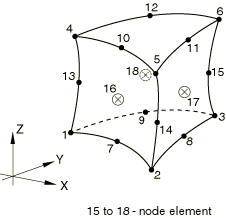
![]() 16–18 are midface nodes on the three rectangular faces (see below for faces 1 to 5). These
16–18 are midface nodes on the three rectangular faces (see below for faces 1 to 5). These ![]() nodes can be omitted from an element by entering a zero or blank in the corresponding position when giving the nodes on the element. Only nodes 16–18 can be omitted.
nodes can be omitted from an element by entering a zero or blank in the corresponding position when giving the nodes on the element. Only nodes 16–18 can be omitted.
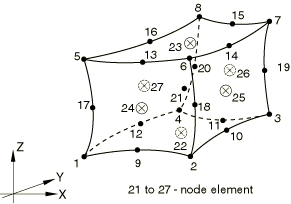
![]() (nodes 22–27) are midface nodes on the six faces (see below for faces 1 to 6). These
(nodes 22–27) are midface nodes on the six faces (see below for faces 1 to 6). These ![]() nodes can be deleted from an element by entering a zero or blank in the corresponding position when giving the nodes on the element. Only nodes 22–27 can be omitted.
nodes can be deleted from an element by entering a zero or blank in the corresponding position when giving the nodes on the element. Only nodes 22–27 can be omitted.

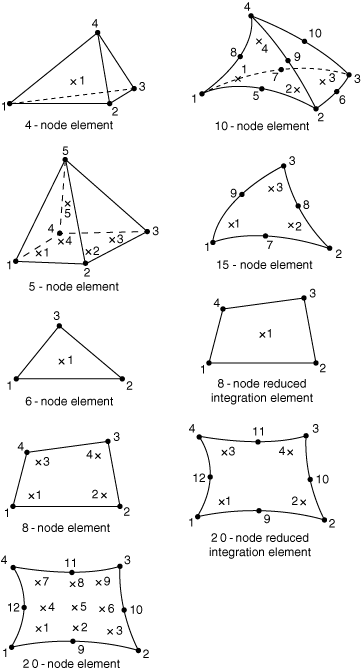
This shows the scheme in the layer closest to the 1–2–3 and 1–2–3–4 faces. The integration points in the second and third layers are numbered consecutively. Multiple layers are used for composite solid elements.
For heat transfer applications a different integration scheme is used for tetrahedral and wedge elements, as described in “Triangular, tetrahedral, and wedge elements,” Section 3.2.6 of the Abaqus Theory Guide.
For linear triangular prisms in Abaqus/Explicit reduced integration is used; therefore, a C3D6 element and a C3D6T element have only one integration point.
For the linear bricks C3D8S and C3D8HS in Abaqus/Standard improved stress visualization is obtained through a 27-point integration rule, consisting of 8 integration points at the elements' nodes, 12 integration points on the elements' edges, 6 integration points on the elements' sides, and one integration point inside the element.
For the general-purpose C3D10HS 10-node tetrahedra in Abaqus/Standard improved stress visualization is obtained through an 11-point integration rule, consisting of 10 integration points at the elements' nodes and one integration point at their centroid.
For acoustic tetrahedra, pyramid, and wedges in Abaqus/Standard full integration is used; therefore, an AC3D4 element has 4 integration points, an AC3D5 element has 5 integration points, an AC3D6 element has 6 integration points, an AC3D10 element has 10 integration points, and an AC3D15 element has 18 integration points.
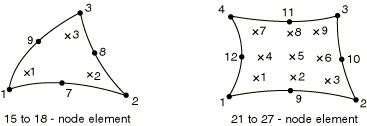
This shows the scheme in the layer closest to the 1–2–3 and 1–2–3–4 faces. The integration points in the second and third layers are numbered consecutively. Multiple layers are used for composite solid elements. The face nodes do not appear.
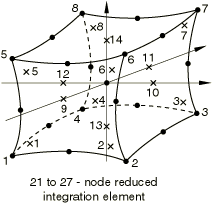
Node 21 is located at the centroid of the element.